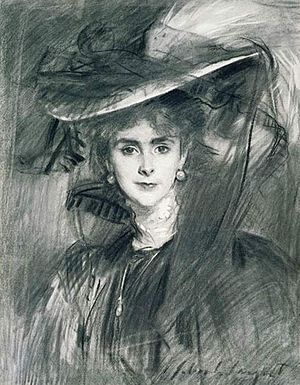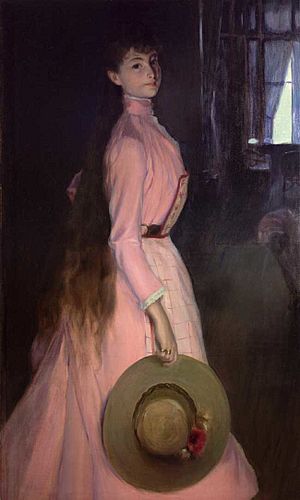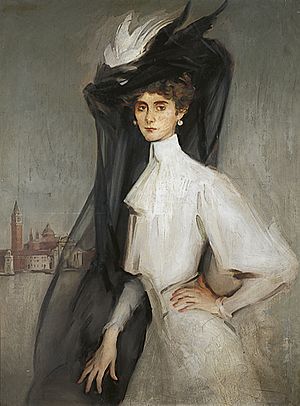Olga de Meyer facts for kids

Baroness Olga de Meyer (born Maria Beatrice Olga Alberta Caracciolo; 8 August 1871 – 6 January 1931) was a British-born artists' model, a well-known person in society, a supporter of the arts, a writer, and a fashion icon in the early 1900s. She was famous as the wife of photographer Adolph de Meyer. People often rumored that she was the natural or god-daughter of King Edward VII of the United Kingdom. After 1916, she preferred to be called "Mahrah de Meyer".
Contents
Olga de Meyer's Early Life and Family
Olga de Meyer was born Donna Maria Beatrice Olga Alberta Caracciolo in London, England. Her family had roots in Portugal, Italy, France, and America. Her father was Gennaro Caracciolo Pinelli, a nobleman from Naples. Her mother was Marie Blanche Sampayo. Marie's father was Antoine François Oscar Sampayo, a French diplomat.
Olga was born on 8 August 1871, at 14 William Street in Chelsea. Her father officially registered her birth in September 1871. There were rumors that Olga was the daughter or god-daughter of the Prince of Wales, who later became King Edward VII. However, historians believe this was unlikely. As a Catholic, Olga could not have been the Prince's god-daughter.
Some people thought that Stanislaus Augustus, 3rd Prince Poniatowski, was her father. He was a friend of her mother. After her mother passed away in 1891, Olga went to Naples. In 1892, she married Prince Marino Brancaccio, a member of another Catholic family. They divorced in Hamburg in June 1899. When Olga married Adolph de Meyer the next month in London, she had a Protestant ceremony.
Olga de Meyer attended King Edward VII's coronation in Westminster Abbey in 1902. She was noticed sitting in the front row of the King's special box. She was there with close friends of the King, including Alice Keppel. In 1916, Olga de Meyer started using the name "Mahrah" because an astrologer suggested it.
Olga de Meyer's Marriages
Olga Caracciolo was married two times:
- Nobile Marino Brancaccio (1852–1920) was a nobleman from Naples. They married in Naples, Italy, on 9 May 1892 (civil ceremony) and 11 May 1892 (religious ceremony). They divorced on 7 June 1899, in Hamburg, Germany. A family friend, artist Jacques-Émile Blanche, called their marriage "a short and most dramatic union."
- Adolph de Meyer (1868–1946) was a famous artist and photographer. Cecil Beaton called him "the Debussy of photography." They married on 25 July 1899 at Holy Trinity Church, Sloane Street, in London. This marriage was a "marriage of convenience," meaning it was for social reasons rather than romantic love.
Olga de Meyer as a Muse and Writer
Olga de Meyer was known for her unique charm. She was described as "tall and slender, with Venetian red hair." She became a muse and model for many famous artists. These artists included Jacques-Émile Blanche, James McNeill Whistler, John Singer Sargent, and Giovanni Boldini. Other artists who admired her were Charles Conder, who painted her portrait, and Aubrey Beardsley. Olga de Meyer also inspired characters in novels by Elinor Glyn and Ada Leverson.
British novelist George Moore did not find Olga's beauty impressive. He once told an artist friend, "She's paintable, I admit, but as to one's daily use, I should rather have the mother than the child. Too slender for me."
In the 1890s, she worked briefly as a society columnist for La Galoise, a newspaper in Paris. As Mahrah de Meyer, the name she took in 1916, she wrote one novel. This autobiographical book was called Nadine Narska (published in 1916). The New York Times said the novel was "morbid, exaggerated, ... [and] guilty of many carelessly written sentences." The Dial described it as "a miscellaneous mixture of paganism, diluted Nietzsche, worldly morals, and the doctrine of reincarnation."
One of de Meyer's short stories, Clothes and Treachery, was turned into a movie. It became The Devil's Pass Key, a silent film from 1919 directed by Erich von Stroheim.
Olga de Meyer as a Sportswoman
Baroness de Meyer was known as the "woman [amateur fencing] champion of Europe." She competed in fencing tournaments in Europe and the United States in the early 1900s. On 6 January 1913, she took part in an exhibition match. This match was held at the Colony Club in New York City. Her opponent was Sibyl Marston, a fencing champion from California.
Olga de Meyer's Passing
Olga de Meyer passed away on 6 January 1931, at the age of 59. She was buried two days later in Freiburg, Baden, Germany.
Sources
- Profile of Adolf de Meyer, broadway.cas.sc.edu
- Meyer, A. de. Of Passions and Tenderness: Portraits of Olga by Baron de Meyer. Marina del Rey: Graystone Books, 1992



